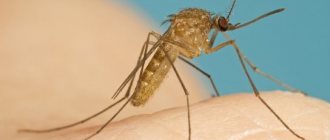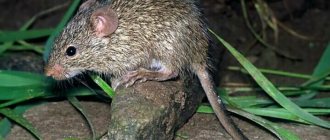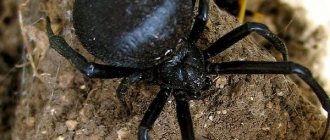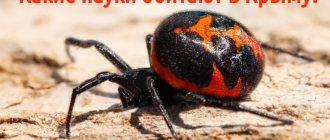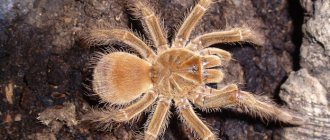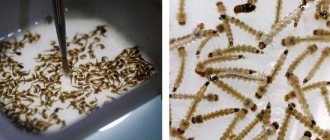The praying mantis is an insect that causes surprise. His habits and behavioral characteristics can shock many people who were previously unfamiliar with this creature. The insect often appears in ancient myths and tales of different countries - in China, for example, mantises were considered the standard of greed and stubbornness. It's hard to believe that these little ones are very cruel. Dealing with their prey at a slow pace, these ruthless insects enjoy the process.
We tried to collect for you the most interesting facts about praying mantises - incredible insects! By devoting a little time to reading, you will learn something new - something with which you can surprise your friends and demonstrate your broad horizons.
It got its name because of the structure of its legs.
Mantises have interestingly folded front legs. When the insect is motionless, its legs are raised and folded in such a way that they resemble a pose in prayer . But in fact, at this moment he is not praying at all, but hunting...
The praying mantis is indeed a very bloodthirsty creature - it could well be called a killer or even a cannibal. During its hunt, it sits motionless, with its front leg extended forward. It looks like a trap - and that's what it is.
At any second, the praying mantis can grab an insect that passes by. Sharp serrations on the inside of the legs help this bloodthirsty creature hold its prey.
Benefits and harms
The praying mantis as an insect does more good than harm. Its diet consists of insect pests, which it destroys in large quantities. But the beetle can also cause harm; by eating harmful insects, it does not disdain bees. Just a few praying mantises can destroy an entire swarm of these beneficial insects in a short period.
Food for the praying mantis
We have found out why the praying mantis is useful and dangerous, but it is interesting to know what representatives of a particular species look like. What structural features do they have and how are they different?
In 50% of cases, females eat males
This fact will probably shock you! Get ready... After mating, the female praying mantis bites off the male's head .
The reasons for this are trivial - after physical activity, the female feels hungry, and the influence of sex hormones leads to an increase in aggressiveness in her behavior. In fact, only 50% of the time the female satisfies her hunger with her sexual partner. The male is much smaller in size, and therefore more agile. He decides for himself whether to become dinner for his partner or “retire.” Males try to approach the female with great caution so as not to catch her eye.
The forelimbs have spines
This is vital because its front legs are its main hunting tool. The praying mantis pounces on its prey with its fang-like forelimbs, intercepting it in just 50 to 70 milliseconds—about six times faster than the blink of an eye. The predator pierces the prey with its spikes, immobilizing it.
While most species have only a few spines, some have up to 30 spines. The thorns also help when jumping from one branch to another.
Photo: Hung Chei/Getty Images
For some species of mantises, mating is not necessary
You already know that after mating, the female eats the male (and sometimes during intercourse). This is due to the greater need for protein in the female when carrying fertilized eggs. As autumn approaches, the females' appetite increases - they eat a lot, which causes their belly to swell. This causes them to move more slowly as they prepare to lay eggs.
Not all praying mantises require mating to lay eggs . Before laying them, the female always chooses a flat surface, and then forms a foamy substance on which the eggs are strengthened.
Reproduction
This is where the most interesting things begin for many; many know the facts that characterize the insect from a not very good side.
The total lifespan of an individual individual lasts no more than a year; during this short period of time, the insect needs to grow, feed itself, protect itself from predators and be able to leave behind offspring.
Reproduction of the praying mantis
Mating season and mating
The mating season for praying mantises begins in the fall; during this period, the male uses his sense of smell to look for a partner who is ready to mate. Previously, he performs a dance for the female, with which he demonstrates his full readiness and sexual maturity. Only after this does the mating process take place, during which the female, without a drop of regret, bites off her partner’s head, often even before the end of the procedure.
Interesting!
Eating a partner does not occur due to the female’s dissatisfaction; thus, the praying mantis replenishes the reserves of certain proteins in the body necessary for laying eggs and enveloping them with a special film.
Laying eggs
After a certain period of time, the female will lay eggs; she usually does this before winter. The insect envelops the offspring with a special sticky substance secreted by its own glands. In science, this substance is called ootheca; it can protect eggs from mechanical stress and protect them from various vagaries of the weather.
The larvae stay in the eggs for different periods of time depending on the species; this period lasts from 3 weeks to 6 months.
Important!
At one time, one female praying mantis can lay from 10 to 400 eggs.
Stages of development
Praying mantises do not immediately hatch from eggs; before this there is another period of development:
- In the laid eggs, an insect larva develops until spring;
- Having hatched, the larva becomes a nymph, a smaller copy of its parents;
- After 4-8 molts, the nymph turns into an adult insect.
Then the whole cycle repeats again, the male looks for the female, she bites and lays eggs.
Can camouflage itself by changing color
The praying mantis is an amazing creature in every way! You can find both green and sand mantises... How do they change color? The fact is that the color of the insect is very variable - it varies from green to dark brown . Camouflage helps them adapt to the background, blending into it: be it earth or grass
. Praying mantises deftly merge with the surface on which they had to find themselves in the first days after the molting process. And finally, this happens in a brightly lit area.
Migrations
Insects are endowed with large wings. They fly up to 5–8 kilometers per day in search of food. During the mating season, an adult mantis can travel up to 15–20 kilometers; reproduction requires a food supply and conditions for laying edema. The arthropod migrates to territories located hundreds of kilometers from its former habitat.
Turns head 180 degrees
The praying mantis has incredible abilities. His head is very mobile, equipped with keen eyes. This is the only insect that can turn its head 180 degrees in different directions , thus giving it a wide view (yes, many would dream of such an ability!)
In addition, despite the fact that mantises have only one ear, they hear everything perfectly, and thanks to the rotation of their heads, not a single future victim of the mantis will be able to escape from it...
LiveInternetLiveInternet
- PodFM.ru - audio magazine (106)
- Jokes (84)
- Astrology (412)
- Zodiac (118)
- Astronomy (129)
- Audio library (284)
- Aphorisms (46)
- Banking (23)
- Without section (25)
- WHITE MAGIC (747)
- AMULETS, TALISMANTS, CHARMS (131)
- CONSPIRACIES, WHISPERS (117)
- Spells on animals and birds. (4)
- Love spells. (5)
- Spells for babies and children. (eleven)
- Conspiracies for men and women. (17)
- Conspiracies for the garden and vegetable garden. (6)
- Conspiracies for family well-being. (10)
- Spells for successful hunting and fishing. (2)
- Conspiracies for success in business and trade. (10)
- Conspiracies for illnesses and injuries. (thirty)
- Magic of stones (142)
- Magic for every day (143)
- Festive (32)
- Manuals (125)
- Library (276)
- Video, news (129)
- Video library (721)
- Video tutorials (319)
- Health (32)
- Internet (47)
- Yoga (6)
- Computer (87)
- Payment systems (14)
- Handicrafts (31)
- Sports (9)
- Dancing (4)
- Photoshop (28)
- Survey questions (47)
- DIVINATION (388)
- Domino (1)
- Maps (6)
- Book of Changes or I Ching (3)
- By coffee grounds (2)
- Various (208)
- Runes (90)
- Tarot (59)
- GADGETS (180)
- HOROSCOPE (1499)
- Vikings (2)
- Voodoo (1)
- Druid Horoscope - Trees (8)
- Druid Horoscope - Flowers (30)
- Mayan Horoscope (6)
- Greek (6)
- Jewish (2)
- Egyptian (14)
- DAILY (399)
- Weekly (154)
- Zoroastrian horoscope (6)
- Indian horoscope (4)
- Indian (6)
- Fortune calendar (64)
- Celtic (2)
- Chinese (31)
- Lunar (115)
- Mythical (2)
- Unusual horoscopes (20)
- Forecasts for the year (142)
- Monthly forecasts (258)
- Various (138)
- Slavic (24)
- Sunny (27)
- Haircuts (63)
- Structural (6)
- Tibetan (8)
- Phoenician (2)
- Sumerian (2)
- Playful horoscopes (40)
- Pagan (3)
- Japanese (2)
- History dates (3112)
- CHILDREN'S THEME (67)
- Tales about your child. (14)
- Dzerzhinsk (339)
- Design (103)
- Interior (59)
- Landscape (12)
- Desktop wallpapers (10)
- Diary design (748)
- Avatars (8)
- Generators (5)
- Comments (16)
- Culinary frames (35)
- Rulers (13)
- Holiday frames (15)
- Dividers (29)
- Note frames (433)
- Craft Frames (10)
- Schemes (35)
- Lessons (15)
- Documentary (633)
- LEISURE AND ENTERTAINMENT (1362)
- AQUARIUM (55)
- Games for leisure (185)
- Calendars (39)
- Competitions (34)
- Postcards (193)
- Gifts for… (300)
- Philately (47)
- Movie (413)
- J.Z.L. (480)
- LAWS, RIGHTS, PROTECTION, OBLIGATIONS, (312)
- Health (1202)
- Celebrities (1156)
- Valery Leontyev (143)
- HERMAN Anna (36)
- Irina Allegrova (93)
- Kirkorov Philip (8)
- Kristina Orbakaite (5)
- MAGOMAEV Muslim Magomedovich (46)
- PUGACHYOVA Alla Borisovna (26)
- Business ideas (from/for) home (314)
- Art (1863)
- Architecture and sculpture (145)
- Painting, graphics (1589)
- Crafts (124)
- Stories (588)
- CALENDAR OF FOLK SIGNS (72)
- CINEMA HALL (945)
- Foreign films (88)
- Musical environment (176)
- Cartoons (140)
- Retro (119)
- TV series (43)
- Fairy tales (47)
- Theater (107)
- TVShow (61)
- FANTASTICA (33)
- Indian films (14)
- Films of Russia (141)
- Pixar films (6)
- and its products (123)
- LEGENDS (55)
- Personal (26)
- Mandala (89)
- Mantra (31)
- Master classes (75)
- Meditation (28)
- PEACE and WAR (339)
- MYSTIC (109)
- MYTHS (720)
- Biblical (267)
- Greece (50)
- Other nations (15)
- Egypt (45)
- Indian (1)
- India (26)
- China (1)
- Scandinavian (69)
- Slavic (220)
- Japan (13)
- Fashion, style, beauty (470)
- My works (40)
- My poems (8)
- Prayers (137)
- MUDRA (20)
- Music, songs (499)
- SCIENCE and TECHNOLOGY (417)
- UNKNOWN (170)
- News (326)
- Affiliate programs (38)
- Search for Truth (360)
- Good to know (912)
- Help (24)
- Proverbs (25)
- Poetry (437)
- Asadov Eduard (29)
- Vasilyeva Larisa (3)
- Henry Wadsworth LONGFELLOW. (34)
- Kipling Rudyard (12)
- World (29)
- Omar Khayyam (12)
- Pushkin A.S. (21)
- Russia (194)
- Filatov Leonid (1)
- Shakespeare William (1)
- Holidays (547)
- I accept orders (my services) (7)
- PARABLES, FABLES (820)
- Prose (369)
- Psychology (399)
- Radio "Friday" (12)
- Recipes (1852)
- Handicrafts (483)
- Knitting (61)
- Carving (1)
- Miscellaneous (167)
- Sewing (135)
- Your own business (102)
- Fairy tales (353)
- Fairy tales (audio) (21)
- Tales of Elena Fedina (44)
- TALES, FICTIONS (103)
- Create your own website (90)
- Dream Interpretation (38)
- Sports (102)
- Poems (773)
- Insurance (15)
- Secrets of our planet (317)
- Tests (892)
- Women only (80)
- TRADITIONS (229)
- TOURISM (travel) (1092)
- Australia (5)
- Abkhazia (3)
- Flights (4)
- ASIA (38)
- America (23)
- AFRICA (21)
- To help tourists (78)
- SPRING (12)
- Cities and countries (414)
- Greece (13)
- EUROPE (109)
- WINTER (13)
- India (58)
- SUMMER (17)
- AUTUMN (12)
- Hotels (21)
- Russia (315)
- Excursions (15)
- Fantasy (139)
- Fauna (944)
- Flora (771)
- Photos (690)
- Photoshop (76)
- Feng Shui (93)
- Housekeeping (104)
- We're losing weight and getting healthier! (103)
- Artist, photo (593)
- Quote (530)
- To be remembered (186)
- Simoron School (59)
- Economics, finance (160)
- This is interesting ! (591)
- Humor (539)
Why is the praying mantis called that?
The praying mantis family has about 800 species, although they are all little different from each other. These insects have long and narrow bodies, six legs, brown or green wings up to 5 cm long. But why is this seemingly quite ordinary insect called somewhat strangely - a praying mantis?
He received this name because of his pose. Very often it can be seen motionless, with its front, largest legs raised up. He stands like this for hours, legs folded, as if he is praying. But this pose is harmless only at first glance. The praying mantis folds its legs in this way not for prayer, but for hunting. As soon as any insect appears nearby, the praying mantis quickly throws its folded legs forward and grabs the victim. Sharp serrations located on the inside of the front legs help the mantis hold it.
Despite such a benevolent name, praying mantises are considered one of the most cruel and bloodthirsty insects. They feed on other insects, killing them mercilessly.
Praying mantises hop on four hind legs and can fly from place to place. Moreover, they are the only insects that can turn their heads to the sides and back and even look over their shoulders. So it is difficult for the victim to dodge them; they will still notice him. Mantises catch prey and, holding it with their paws, slowly savor it.
This insect has long been of interest to scientists and fear of all people who have heard about it. People call praying mantises “soothsayers” and “mule killers.” The first name, obviously, also came from the meaningful pose of the deceitful “holy man,” and the second comes from the belief that the saliva of a praying mantis can poison a mule.
Share on the page
Next chapter >
Member of the cockroach order
If you look at a praying mantis (for example, one that lives in Asia), you will notice a strong resemblance to another representative of the insect world - the cockroach. That’s right - the praying mantis is part of the cockroach order . In the narrow sense of the word, cockroaches share the same type and anatomical features of wings and mouthparts. It is noteworthy that the structure of the ootheca is different in cockroaches and mantises.
Interesting fact: the praying mantis grows up to 11 cm in length - this fact may frighten those who have an aversion to insects.
№3
Mantises are an order of insects that are six-legged invertebrates with exoskeletons, segmented bodies and articulated legs. The main defining feature of praying mantises is their long, bent front legs. The insect holds these legs in a bent position under its head, as if it were praying (hence the name).
Mantises are predators
So, you have already learned that the praying mantis is a predatory insect. Let's talk about this in more detail. This insect lives throughout the entire globe, perhaps with the exception of the polar regions, and adapts well to different conditions. Prefers hot climates most. The appearance of this creature resembles an alien! It has a triangular head shape, one ear, and two compound eyes.
The praying mantis is a 100% predator . This is a rather voracious insect, capable of consuming thousands of butterflies, cockroaches, grasshoppers and dragonflies in just a couple of months. Larger individuals dare to attack even mice, birds and frogs.
The praying mantis never feeds on dead insects - its prey must be alive, in addition, it is desirable that it resists... The praying mantis sits motionless, waiting for the prey, and as soon as it approaches, the predator grabs it with its front paws, firmly fixing the prey with its spines. No one can escape from the grip of the praying mantis...
The feast begins with the biting of living flesh - the mantis watches with fascination as its victim suffers. But that's not the whole story about the praying mantis - sometimes they eat each other.
Interesting Facts
More than two thousand species of mantises have been identified
There are about 2000 species of mantises on our planet; it is interesting that they are all very different from each other in their lifestyle and coloring . The most common are common mantises (48-75 mm) - in Russia they are most often found in the steppes, as well as in southern Siberia, the Far East, the North Caucasus, Central Asia, etc.
Desert species of these insects are characterized by their small size and in the process of movement they resemble tiny workers - ants. The most common colors of praying mantises are green and white-yellow. On average, an insect lives about a year.
Females prefer not to fly
For hours, and sometimes even days, the praying mantis sits without moving.
It fits perfectly into the environment, so the chance of noticing it is minimal. Despite its perfectly developed wings, the praying mantis moves very slowly, and if we talk about flying, it does it very poorly. A slowly flying insect, which can be seen from afar, is an easy prey for birds, so the praying mantis does not fly unless absolutely necessary, and females generally fly only in the most extreme cases - this is too risky . They are larger than males in size, and their wings are rather weak.
A strange way to lay eggs
Mantises take care of their offspring; they lay eggs in peculiar capsules - ootheca. They are laid in several rows and filled with a special material that contains protein.
These manipulations help the eggs to be preserved at low temperatures, and also protect them from exposure to deadly and harmful substances.
Ancient Egyptians worshiped praying mantises
Praying mantises are quite ancient insects that have become famous for their fearless nature and unusual appearance. In Ancient Egypt, this amazing insect left its mark in the form of an image on the tomb of the ancient Egyptian pharaoh - Ramesses II.
Religious Egyptians even mummified them. The praying mantis had the right to his sarcophagus and the afterlife . Archaeologists opened such a sarcophagus in 1929, but the mummy disintegrated too quickly, but remained in the photographs.
14 0
A strange way to lay eggs
Mantises take care of their offspring; they lay eggs in peculiar capsules - ootheca. They are laid in several rows and filled with a special material that contains protein.
These manipulations help the eggs to be preserved at low temperatures, and also protect them from exposure to deadly and harmful substances.
